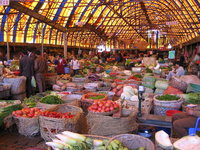Difference between revisions of "Post-scarcity"
| Line 1: | Line 1: | ||
{{pagebg}} | {{pagebg}} | ||
[[Image:Market.jpg|right|200px|Market]] | [[Image:Market.jpg|right|200px|Market]] | ||
| − | The '''post-scarcity age''' is an anticipated period where due to advancing technology and efficient use of natural resources there will be a great abundance of the material items, goods and services that people need, | + | The '''post-scarcity age''' is an anticipated period where due to advancing technology and efficient use of natural resources there will be a great abundance of the material items, goods and services that people need, achievable with a minimal impact to the environment. It should not matter where you live. |
Many fictional visions of post scarcity involve as yet undeveloped technologies and unproven theories but it is interesting to note that material abundance can be produced with existing technologies. Food is one example, where there is more than enough for everyone on the planet, but it is logistics, politics and economics that prevents a more egalitarian distribution. There exists far more energy, raw material and biological resources on Earth than humanity requires, it is a matter of developing systems that use and distribute them more efficiently. | Many fictional visions of post scarcity involve as yet undeveloped technologies and unproven theories but it is interesting to note that material abundance can be produced with existing technologies. Food is one example, where there is more than enough for everyone on the planet, but it is logistics, politics and economics that prevents a more egalitarian distribution. There exists far more energy, raw material and biological resources on Earth than humanity requires, it is a matter of developing systems that use and distribute them more efficiently. | ||
Revision as of 01:01, 3 October 2006
|

